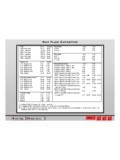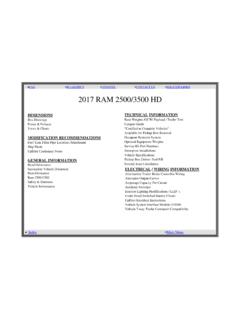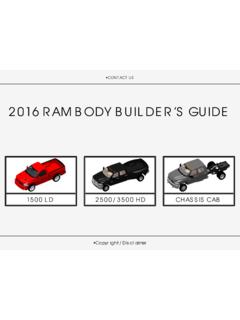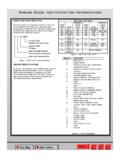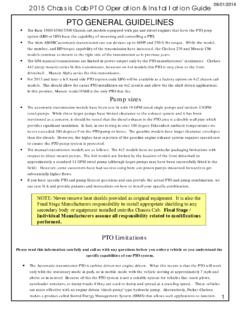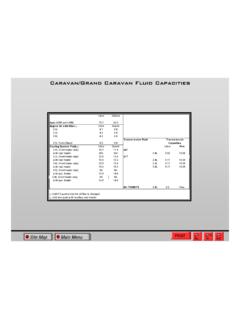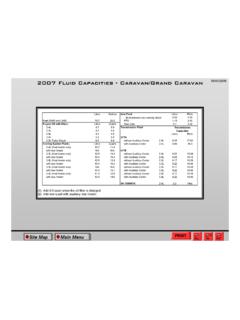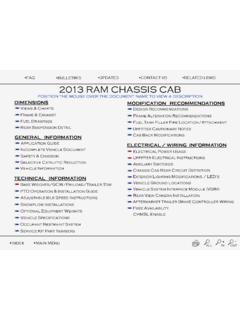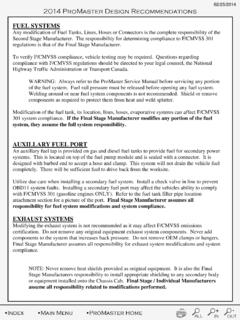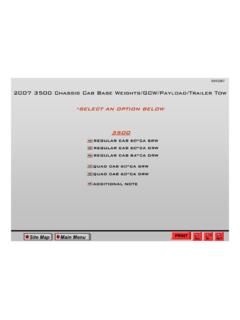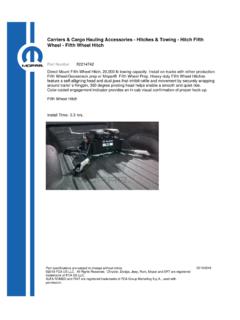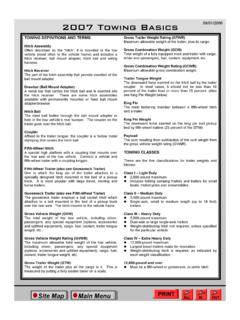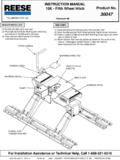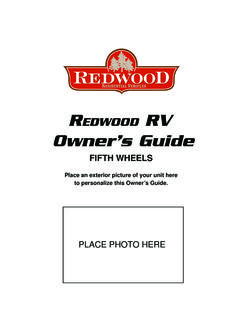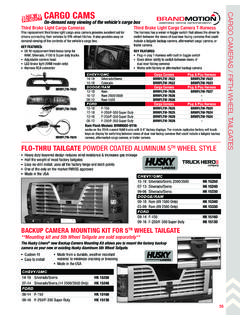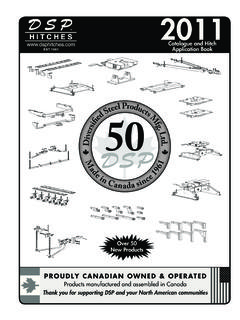Transcription of TOWING DEFINITIONS AND TERMS Gross Trailer …
1 +-2015 TOWING BASICS I N D E X M A I NM E N UA L L I N O U T+- TOWING DEFINITIONS AND TERMSH itch AssemblyOften described as the hitch , it is mounted to the towvehicle (most often to the vehicle frame) and includes ahitch receiver, ball mount adapter, hitch ball and ReceiverThe part of the hitch assembly that permits insertion of theball mount (Ball Mount Adapter)Ametal bar that carries the hitch ball and is inserted intothe hitch receiver. There are some hitch assembliesavailable with permanently mounted or fixed ball BallThe steel ball bolted through the ball mount adapter orholein the tow vehicle s rear bumper. The coupler on thetrailergoes over the hitch to the Trailer tongue, the coupler is a hollow metalstamping that covers the hitch HitchA special high platform with acoupling that mounts over therear axle of the tow vehicle.
2 Connect a vehicle and fifth-wheel Trailer with a coupling Trailer (also see Gooseneck Trailer )Onein which the king pin of the Trailer attaches to a speciallydesigned hitch mounted in the bed of a pickup truck. Itis most popular with large travel, moving and Trailer (also see Fifth-Wheel Trailer )Thegooseneck Trailer employs a ball socket hitch whichattaches to a ball mounted in the bed of a pickup truck overthe rear axle. The hitch mounts to the vehicle Vehicle Weight (GVW)The total weight of the tow vehicle, including driver,passengers, any specialequipment (options, accessoriesand upfitted equipment), cargo, fuel, coolant, Trailer tongueweight, Vehicle Weight Rating (GVWR)The maximum allowable total weight of the tow vehicle,including driver, passengers, any special equipment(options, accessories and upfitted equipment), cargo, fuel,coolant, Trailer tongue weight, Trailer Weight (GTW)The weight of the Trailer plus all the cargo in it.
3 This ismeasured by putting a fully loaded Trailer on a Trailer Weight Rating (GTWR)Maximum allowable weight of the Trailer , plus its Combination Weight (GCW)Total weight of a fully equipped truck and Trailer with cargo,driver and passengers, fuel, coolant, equipment, Combination Weight Rating (GCWR)Maximum allowablegross combination Tongue WeightThe downward force exerted on the hitch ball by the trailercoupler. In most cases, it should not be less than 10percent of the Trailer load or more than 15 percent. (Alsosee King Pin Weight below)King PinThe main fastening member between a fifth-wheel hitchand a Pin WeightThe downward force exerted on the king pin and pickupbed by fifth-wheel trailers (25 percent of the GTW)PayloadThe sum resulting from subtraction of thecurb weight fromthe Gross vehicle weight rating (GVWR).
4 These are the five classifications for Trailer weights andhitches: TOWING CLASSESC lass I 2,000-pound maximum Includes folding camping trailers and trailers for small boats,motorcycles and snowmobilesClass II 3,500-pound maximum Single-axle, small to medium length (up to 18 feet) trailersClass III 5,000-pound maximum Dual-axle or large single-axle trailers Weight-distributing hitch not required, unless specified for theparticular vehicleClass IV 5000-pound non- weight distributing 12,900-pound maximum weight distributing 1290 lbs. tongue weight Largest travel trailers made for recreation Weight-distributing hitch is required; as indicated by each weightclassificationClass V 17000 pound weight distributing or non- distributing 1800 lbs. tongue weight Equipment trailer17,000-pound and over Mustbe a fifth-wheel or gooseneck, or pintle hitchA L L I N O U T+-2014 TOWING BASICSNOTES ON GETTING HITCHEDW eight-Carrying HitchA weight-carrying hitch supports the Trailer tongue weight, just asif it were luggage located at a hitch ball or some other connectedpoint of the truck.
5 These kinds of hitches are commonly used totow small and medium sized are three styles of weight-carrying hitches: Fixed Drawbar in which the ball platform is permanentlywelded to the hitch Removable Drawbar in which the ball platform isremovable. This hitch is commonly referred to as a utility ballmount for Class III hookupsFixed DrawbarRemovable DrawbarPintle HitchWeight-Distributing HitchA weight-distributing system includes a receiver attached to thetow vehicle, plus a removable hitch head and spring barassembly that fits into the receiver opening and hook up bracketsthat connect the spring bars to the Trailer frame. This allowstowing of trailers with greater tongue weights typically Class IVcategories up to 12,000 HitchA fifth-wheel hitch is a special platform with a coupling that mountsover the rear axle of the tow vehicle.
6 It connects a vehicle and fifth-wheel Trailer with a coupling king pin. It is most popular with largetravel, moving HitchTOWING AND AXLE RATIOSOn rear-wheel-drive vehicles, rear-axle ratio is an important partof a successful TOWING equation. It is expressed as a ratiobetween the driveshaft revolutions per minute and the rear axle'srevolutions per minute. It is always given as a numerical shaftexpression like :1. This means the small pinion gear at theend of the drive shaft must rotate times for every singlerotation of the rear axle / rear-axle ratio in the spectrum of those offered has a plusand minus. A ratio that is "low" in the number of drive shaftrotations for every axle rotation results in lower engine rpm and inbetter fuel economy, longer engine life and quieter running. But itwon't be good for quick acceleration, climbing grades, carryingloads or pulling a "high" ratio, one with a high number of drive shaft turns like :1 example above, is better for quick acceleration, climbinggrades, carrying loads or pulling a Trailer .
7 However, it results inlower fuel economy and is noisier when running at high any application, it is best to determine a ratio that will enableyour Ram vehicle to pull a Trailer with the engine operating closestto its optimal power range - where peak torque and peakhorsepower meet on the engine power curve chart. Thismaximizes power, efficiency fuel economy. It is best to determinea ratio that will give good Trailer TOWING power withouthandicapping non- TOWING performance too Distributing Hitch I N D E X M A I NTOWING MATHThe TOWING charts located in the Base Weights / GCW /Payload section of each vehiclein the2012 Body Builder sGuideshows Model Engine Transmission Axle ratio GVWR Payload Front and rear curb weight Front and rear GAWR GCWR Max allowable Trailer weightTo use the TOWING charts, first calculate the GCW of thetowing vehicle and GTW of Trailer to make sure thateverything falls within the GCWR listed.
8 This is done byadding the GVW to the Gross Trailer weight. Next,calculate the total weight to be towed. This includes anycargo or tongue weight must also tongue weight should be more than 10 percent andless than 15 percent of the maximum Trailer weight. TheKing Pin weight should be more than 15percent and lessthan 25 percent of the maximum Trailer :The Maximum Trailer Weight and Payload in theTowing Tables are based on one driver weighing 150 there is greater payload (passengers, cargo, vehicleoptions, accessories, and upfit equipment), it must beincluded in vehicle and/or Trailer weight AND CONDITIONSD iesel Exhaust brake or "Jake Brake" UsageAn exhaust brake or "Jake Brake" is recommended forDodge 3500 Pickup and Chassis Cab models pulling atrailer weight of 10,000 pounds or Hitch RequirementChrysler Group LLC requires that for warranty coverage,vehicles TOWING trailers with a weight rating of 17,000pounds or more must be equipped with a fifth-wheel orgooseneck of the GTW ratings is intended to provideacceptableperformancefornormalcon ditionsoftemperature, grade, and altitude.
9 Extreme conditions willrequire selection of a higher axle ratio and/or a higherpowered engine. Ram trucks equipped with CumminsIntercooled Turbo Diesel engines will have a minimalpower loss at high altitude. These ratings must bedecreased by the weight of any optional equipment, trailerhitch, cargo in the tow vehicle, and passengers other thanthe driver. To determine the GTW, subtract the towvehicle curb weight and 150 pounds (allowance for thedriver) from the maximum allowable Trailer weight for vehicles withmax option content are listed in the Model Lineup sectionsof each vehicle in the Body Builder s Guide. A maximumengine cooling option may be required to achieve themaximum Trailer weight rating and :When hauling cargo or TOWING a Trailer , do not overload thevehicle or can cause a loss of control,poor performance or damage to brakes, axle, engine,transmission, steering, suspension, body structure or weightTo determine the maximum Trailer tongue weight, multiplythe Gross Trailer weight (GTW)by 15 percent.
10 The idealtongue weight should be about 13 percent. However, themaximum tongue weight on a class III bumper hitch islimited to 500 lbs. and a class IV receiver hitch is limitedto 1,045 lbs. For maximum king pin weight on fifth-wheelapplications, multiply the GTW by 25 break-in procedures Caution: During the first 805 km (500 miles) a new vehicle isdriven, do not tow a Trailer . Doing so may damage thevehicle. Limit speed to (80 km/h) 50 mph during the first 805km (500 miles) of ModificationChrysler Group LLC doesn't recommend any modificationsor alterations to the frame assembly. Modifications oralterations ( hole drilling, welding, etc.) to the frameassembly are the responsibility of persons performingthese modifications or alterations. Anyone altering theframe must assure complete responsibility for assembly,performance, reliability and compliance of applicableFMVSS requirements.
